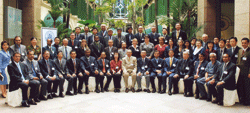
In the News
Blue Roses for Valentine’s Day

Courtesy of Suntory
“Roses are red, violets are blue,” go the old St. Valentine’s Day ditties. But no more. This year,the world’s first true blue roses will go on sale in Japan in time for February 14.
The quest for a blue rose intensified in 1840 when the horticultural societies of Britain and Belgium offered a 500,000 franc prize to the first plant breeder to produce such a flower. Over the next 160 years, plant breeders would create many new hues, with lilac and grey varieties coming closest, but the blue rose remained elusive and was dubbed an impossible dream.
Florigene Ltd in Australia, a subsidiary of Suntory Ltd, Japan, was founded in 1986 with the express goal of using gene technology to create the first true blue rose. In 2004, geneticists at the biotech company finally cracked the DNA code of the rose. The prototype they engineered was pale mauve, but had the genetic potential to produce roses from the palest to the darkest of blues. After four years of further refining, Suntory is now bringing the blue rose to market in Japan.
________________________
Forum for IP Offices in Asia and the Pacific Region

Photo: IPOS
More than 50 heads and senior representatives of national IP offices from 29 countries in Asia and the Pacific gathered in Singapore from December 4 to 6 to exchange views on current issues and developments affecting the IP offices in the region. The event was jointly organized by WIPO and the Intellectual Property Office of Singapore (IPOS).
Discussions at the forum revolved around seven broad themes: (i) current challenges and opportunities; (ii) development of IP policy and strategy; (iii) effective use of information technology for managing IP business processes; (iv) human resource skill sets and requirements for efficient administration of IP rights; (v) encouraging respect for IP through public outreach and awareness building programs; (vi) best practices in enforcing IP rights; and (vii) strengthening public-private partnership for effective use of IP system.
Participants shared their national perspectives, experiences and best practices in relation to each theme under discussion. Active deliberations during the three-day event led to the adoption of a common document outlining common approaches and measures that could help in meeting the challenges, and identifying future priorities and needs of IP offices in region.
Facilitating the use of IP system for economic, social and cultural development and transforming the potential of IP into concrete and tangible benefits is a major challenge facing developing and least developed countries. The forum recognized the central position which IP offices have as drivers and agents of such transformation, and emphasized the need for them to play a proactive role in the process.
________________________
Jockeying for Invention Prize

Robots like this one have replaced the use of small boys as jockeys. Photo: K-Team
A robot camel jockey carried off a top prize at the first International Invention Fair of the Middle East, held in Kuwait in October. The award went to Mr. Rashed Ali Ibrahem of the Qatar Scientific Club.
Camel racing is a popular sport in the Persian Gulf. Until recently, the camels were raced exclusively by child jockeys in hazardous conditions. Responding to human rights concerns, the governments of Kuwait, Oman, Qatar and the United Arab Emirates banned the participation of children in the races, but did not succeed in eliminating the practice. In search of an alternative, the Qatar Scientific Club created a prototype robot jockey. It was too big, so they approached K-Team, a leading Swiss robotics company, for help The result was a 26kg robot jockey, with a child-like appearance and sprayed with traditional Arab perfume in order to trick the camels – very nervous creatures – into accepting them. The robots are controlled remotely using a laptop and joystick. Following the success of the first trials in 2005, even the most skeptical camel owners were rapidly won over.
In two short years, the robots seem to have achieved their objective. Gone are the boy jockeys. Mohamed Ali El Wahidi, a camel trainer in the Emirates, told National Public Radio that the robots have transformed camel racing – there is no more worry about children falling off and being trampled by the camels, and race times have improved dramatically as the robots have gotten lighter.
________________________
Ports in China and EU Share Information to Fight Counterfeiting
Ports are the point of entry and exit for many of the counterfeited goods – fake medicines, foods, toys, etc – that endanger lives and threaten public safety. At the end of January, the European Union (EU) and China unveiled plans for an intelligence network to share information among ports to crackdown on counterfeiting. An EU anti-counterfeiting official will also be stationed in Beijing to work with Chinese authorities.
Despite the increased efforts of the Chinese authorities to crackdown on counterfeiting, EU Customs Commissioner Laszlo Kovacs said that China is currently the main source of counterfeit goods seized in European ports. The intelligence network will help to tighten enforcement, resulting in greater controls in both European and Chinese ports.
________________________
Happy Birthday to Toblerone®

©Kraft Foods Suisse SA
A triangular shaped bar with a white, honey and almond center enveloped in rich milk chocolate – Theodor Tobler and Emil Baumann came up with the “secret recipe” for the first Toblerone in 1908. They registered the name – a play on the words Tobler and torrone, the Italian for nougat – as a trademark in 1909. Owned and distributed today in over 110 countries by the Kraft Company, Toblerone launched celebrations for its 100 birthday in Berne (Switzerland), the town of its creation.
The triangular shape of the Toblerone was registered as a three-dimensional trademark under the Madrid System (International Registration Number 615992) in 1994. Tobler created the shape to resemble the Matterhorn mountain, pictured on the packaging. Each chocolate triangle in the Toblerone is called an Alp. A bear, the symbol of the city of Berne, is concealed in the logo.
The WIPO Magazine is intended to help broaden public understanding of intellectual property and of WIPO’s work, and is not an official document of WIPO. The designations employed and the presentation of material throughout this publication do not imply the expression of any opinion whatsoever on the part of WIPO concerning the legal status of any country, territory or area or of its authorities, or concerning the delimitation of its frontiers or boundaries. This publication is not intended to reflect the views of the Member States or the WIPO Secretariat. The mention of specific companies or products of manufacturers does not imply that they are endorsed or recommended by WIPO in preference to others of a similar nature that are not mentioned.